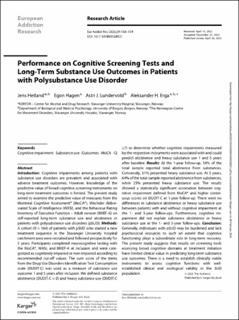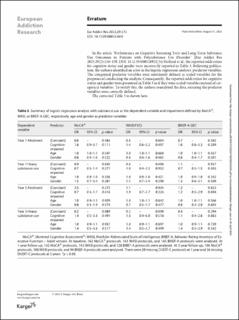| dc.contributor.author | Hetland, Jens | |
| dc.contributor.author | Hagen, Egon | |
| dc.contributor.author | Lundervold, Astri J. | |
| dc.contributor.author | Erga, Aleksander Hagen | |
| dc.date.accessioned | 2024-03-22T10:27:27Z | |
| dc.date.available | 2024-03-22T10:27:27Z | |
| dc.date.created | 2023-06-14T15:59:29Z | |
| dc.date.issued | 2023 | |
| dc.identifier.issn | 1022-6877 | |
| dc.identifier.uri | https://hdl.handle.net/11250/3123794 | |
| dc.description.abstract | Introduction: Cognitive impairments among patients with substance use disorders are prevalent and associated with adverse treatment outcomes. However, knowledge of the predictive value of broad cognitive screening instruments on long-term treatment outcomes is limited. The present study aimed to examine the predictive value of measures from the Montreal Cognitive Assessment® (MoCA®), Wechsler Abbreviated Scale of Intelligence (WASI), and the Behaviour Rating Inventory of Executive Function – Adult version (BRIEF-A) on self-reported long-term substance use and abstinence in patients with polysubstance use disorders (pSUD).
Methods: A cohort (N = 164) of patients with pSUD who started a new treatment sequence in the Stavanger University Hospital catchment area were recruited and followed prospectively for 5 years. Participants completed neurocognitive testing with the MoCA®, WASI, and BRIEF-A at inclusion and were categorized as cognitively impaired or non-impaired according to recommended cut-off values. The sum score of the items from the Drug Use Disorders Identification Test Consumption scale (DUDIT-C) was used as a measure of substance use outcome 1 and 5 years after inclusion. We defined substance abstinence (DUDIT-C = 0) and heavy substance use (DUDIT-C ≥7) to determine whether cognitive impairments measured by the respective instruments were associated with and could predict abstinence and heavy substance use 1 and 5 years after baseline.
Results: At the 1-year follow-up, 54% of the total sample reported total abstinence from substances. Conversely, 31% presented heavy substance use. At 5 years, 64% of the total sample reported abstinence from substances, while 25% presented heavy substance use. The results showed a statistically significant association between cognitive impairment defined from MoCA® and higher continuous scores on DUDIT-C at 1-year follow-up. There were no differences in substance abstinence or heavy substance use between patients with and without cognitive impairment at the 1- and 5-year follow-ups. Furthermore, cognitive impairment did not explain substance abstinence or heavy substance use at the 1- and 5-year follow-ups.
Conclusion: Generally, individuals with pSUD may be burdened and lack psychosocial resources to such an extent that cognitive functioning plays a subordinate role in long-term recovery. The present study suggests that results on screening tools assessing broad cognitive domains at treatment initiation have limited clinical value in predicting long-term substance use outcomes. There is a need to establish clinically viable instruments to assess cognitive functions with well-established clinical and ecological validity in the SUD population. | en_US |
| dc.language.iso | eng | en_US |
| dc.publisher | Karger | en_US |
| dc.rights | Navngivelse 4.0 Internasjonal | * |
| dc.rights.uri | http://creativecommons.org/licenses/by/4.0/deed.no | * |
| dc.title | Performance on Cognitive Screening Tests and Long-Term Substance Use Outcomes in Patients with Polysubstance Use Disorder | en_US |
| dc.type | Journal article | en_US |
| dc.type | Peer reviewed | en_US |
| dc.description.version | publishedVersion | en_US |
| dc.rights.holder | Copyright 2023 the authors | en_US |
| cristin.ispublished | true | |
| cristin.fulltext | original | |
| cristin.qualitycode | 1 | |
| dc.identifier.doi | 10.1159/000528921 | |
| dc.identifier.cristin | 2154569 | |
| dc.source.journal | European Addiction Research | en_US |
| dc.source.pagenumber | 150-159 | en_US |
| dc.identifier.citation | European Addiction Research. 2023, 29 (2), 150-159 . | en_US |
| dc.source.volume | 29 | en_US |
| dc.source.issue | 2 | en_US |


